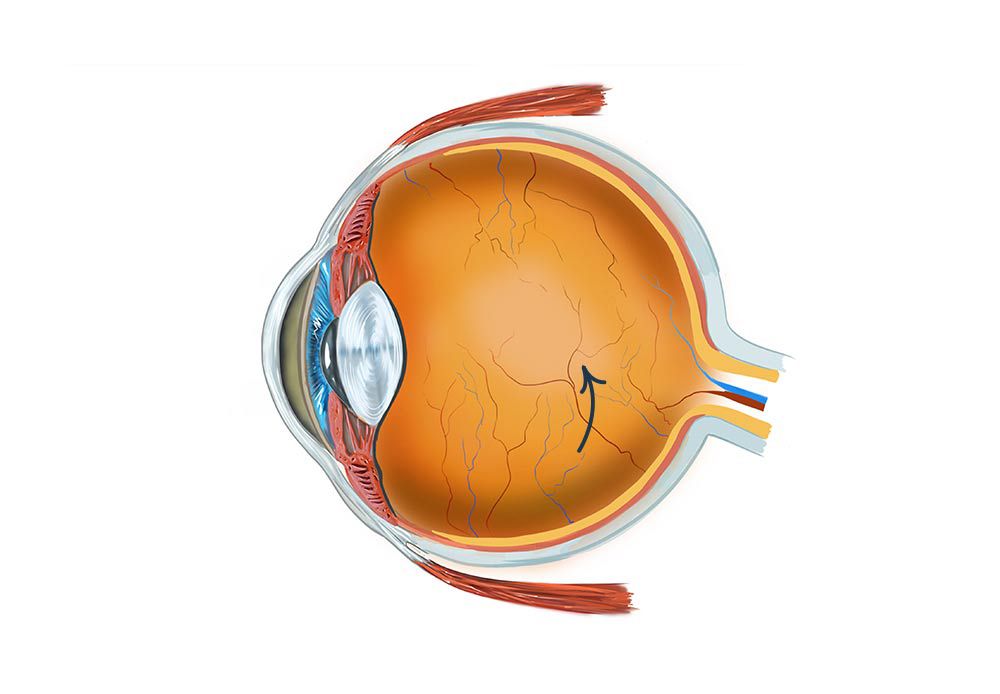Eye stroke: how to recognise and treat retinal vein occlusion

An eye stroke, also called retinal vein occlusion, is a circulatory disturbance in the eye. How do you know what's behind it? How does an eye stroke manifest and how can you treat it successfully?
Find all the information you need at a glance at Lentiamo.
What is an eye stroke?
An eye stroke is an acute circulatory disorder in the eye that is caused by blood clots or deposits. As in the case of a heart attack, the tissue in the eye, the retina or the optic nerve are no longer sufficiently supplied with blood and nutrients.
The retina can be adversely affected with permanent consequences which can even lead to blindness.
If you have an eye stroke, you must act quickly because every minute counts. There's no need to worry however because a sudden attack can usually be treatedif it's detected in time. Take a look at the symptoms of an eye stroke. Glasses or contact lenses generally will not help vision loss due to stroke.

What are the symptoms of an eye stroke?
You won't recognise an eye stroke right away because it may appear without signs and is usually painless. Since the healthy eye can compensate for the the loss of vision, you may not notice the eye stroke at all or you may notice it too late.
Be aware of these 3 eye stroke symptoms
An eye stroke is usually confined to one eye. If you experience
- restrictions in vision
- a black veil before the eye
- or vision failures
you should act immediately and consult an ophthalmologist to seek treatment. Find out more information on how to treat retinal vein occlusion in the rest of this article.
What are the causes of an eye stroke?
Eye strokes are caused by narrowed or blocked blood vessels in the eye, which can be caused by blood clots or deposits. The blood clots either form directly in your eye or develop in other vessels, such as the carotid artery, and are carried into the eye.
When a blood clot sticks, it forms a plug that reduces or completely stops blood flow. Treatment will vary depending on whether the blockage occurs in the arteries or veins.
There are two types of eye stroke: retinal artery occlusion and retinal vein occlusion. In both cases, your retina isn’t supplied with enough oxygen and nutrients to your retina. The effects of this can be seen in the symptoms shown above.
What are retinal artery occlusion and retinal vein occlusion?
Retinal arterial occlusion: Arteries are responsible for the blood supply and therefore the supply of nutrients and oxygen to your eye. Arterial occlusion is caused by migrating blood clots that become lodged in your artery in the eye. The retina in the eye is no longer supplied with enough oxygen. The longer it lasts, the greater the damage.
Studies show that people with pre-existing conditions such as high blood pressure, heart valve defects, narrowing of the carotid artery or diabetes are at higher risk.
Retinal vein occlusion: Veins carry blood away from your eye towards your heart. A vein occlusion blocks the draining blood and causes congestion in your eye, also called thrombosis in the eye. The congestion causes swelling of the tissues and blocks the neighbouring arteries, leading to a lack of blood supply to the eye.
The main cause of eye strokes is venous occlusion, which can lead to blindness, especially in older people. Affected individuals usually have a pre-existing condition such as diabetes, vascular disease or high blood pressure.
How to treat an eye stroke
The aim of treating an eye stroke is to restore blood flow to your eye and, if necessary, to reduce swelling. Your doctor will first determine whether you have an arterial or venous occlusion and how badly the tissue is already affected.

In the case of an arterial occlusion, your eye is completely cut off from the oxygen supply, which can have consequential damage after only 60 to 90 minutes. The doctor tries to loosen the blockage immediately, which is possible with blood-thinning medication that dilates the vessels. The stuck blood clot can then be flushed away. If the blockage persists, a minor surgical procedure might help.
Once the blood flow is restored, your retina can regenerate, at least partially.
In the case of a vein occlusion, there is often swelling which consists of accumulated fluid. The doctor may give blood-thinning medication which will help the fluid to drain. To make the effect more effective, the medication can be injected directly into the eyeball.
Laser treatment is also often used. This treatment closes leaks and also prevents the formation of new blood vessels in the eye.
How dangerous is an eye stroke?
If you don't act quickly, an eye stroke can lead to loss of vision. An eye stroke is an emergency and should be treated immediately to prevent long-term damage. If you experience any of the above please contact your ophthalmologist immediately.
Who is at risk for an eye stroke?
Since an eye stroke is caused by constricted or blocked blood vessels, the risk factors are the same as for other vascular diseases, such as a heart attack or stroke. You should be particularly careful if you:
- are at an advanced age
- are male (men are more often affected than women)
- suffer from high blood pressure
- suffer from diabetes
- suffer from arteriosclerosis
- smoke
- exercise infrequently
- have elevated blood lipid and cholesterol levels
Read more
Want to learn about other risk factors? Read the Lentiamo eye diseases guide to learn more about topics such glaucoma.







Comments